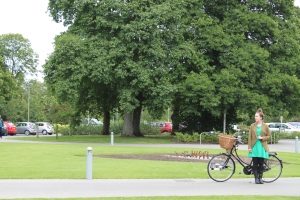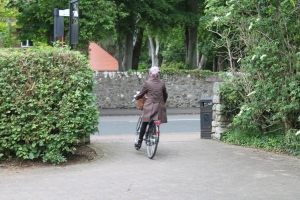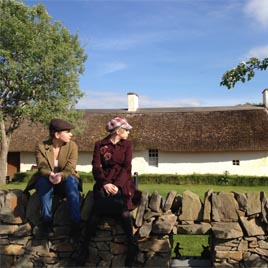Month: June 2014
Reclaiming the Rhyme
Last weekend the Robert Burns Birthplace Museum hosted an inspired new play by Victoria Bianchi, “Causeway: The Story of the Alloway Suffragettes”. Just to give a quick recap of the piece, the talented Pamela Reid and Annaliese Broughton embody two famous Suffragettes, Francis Parker and Ethel Moorhead, respectively, and bring us back to 1914 at the dawning of the Great War. Although the war was upon the world, Francis and Ethel insist that Scotland had already been fighting, but for something else: women’s suffrage.
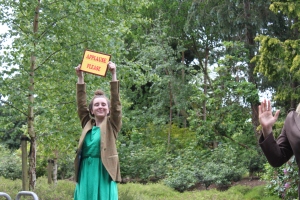
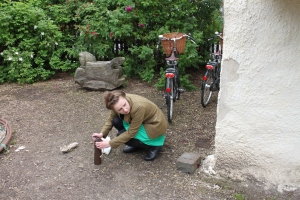

Causeway brings visitors on a journey retracing the steps of Francis and Ethel from Glasgow all the way to Alloway, who went with the intention of blowing up Burns Cottage as a message on behalf of the Suffragette movement. There is another particularly interesting way in which the suffragettes voiced their opinions, not only in Bianchi’s production, but in history as well.
Suffragettes, named for their more militant approach to gaining women’s right to vote, also used the medium of song and poetry to voice their cause. They composed songs based on tunes and hymns, created original anthems, and adapted soldier’s marching songs. Even Burns songs inspired sSffragettes, for example, the 1870s song titled “Human Equality” by the social activist William Lloyd Garrison, is believed to be supplemental to “A Man’s a Man for a’ That”.
So why are we talking about this 100 years later, and how is it relevant to the Robert Burns Birthplace Museum?
Francis Parker was arrested and put on trial after the attempted bombing of Burns Cottage, and was said to have quoted Robert Burns’ Scots Wha Hae. Although we can only imagine the speech made by Parker on trial, Bianchi eloquently peppered in Burns’ quotes and verses in Francis’ speech and throughout the entirety of the play in order to illustrate how people used, and still today use Burns with political and ethical motivations.
The actor Reid passionately channelled Parker’s spirit in a fierce dismissal of the use of Burns as a symbol of masculinity and arguing that the Suffragettes were not attempting to attack Burns but the initiatives of the patriarchy. This makes a powerful point against the unfortunate truth that Robert Burns’ words can be reinterpreted in a multitude of different ways, and not always for causes with which we might agree. Bianchi makes clear that at that time (and perhaps still today!), Burns was being used to exclude people from having power, in this case, specifically women.
Bianchi perfectly executes the true story of two women who were in the fight to reclaim the words of Robert Burns and claim their right for the vote, reminding us to consider that people may use the words of Burns with specific motivations.
For an unadulterated picture of Burns and women’s equality, it is worth looking into his piece “The Rights of Woman”. Some believe that it functioned as a mocking response to Wollostone’s “A Vindication of the Rights of Woman”, published earlier in the same year. But of course, as with every Burns poem, we can only speculate how Burns felt, and what he would have thought of the women’s Suffragette movement is anyone’s guess.
A Day in the Life of a … Learning Intern
What’s the first thing you did when you arrived this morning?
o I sat down at my desk and checked my emails. Then I moved on to panicking over helping lead my first workshop. I typed out a small script to follow when leading part of the workshop, which I later abandoned in favour of improvisation, which may or may not have been a mistake!
Give me a brief description of what you did today.
o Today I helped lead the Being Burns workshop with a small group of 9 kids. I have terrible stage fright so that was a challenge, but here I am, living to tell the tale. Then I moved on to have a lunch break accompanied by numerous pieces of tablet. The afternoon was spent editing my project’ ’15 Things at RBBM Before 5pm’, which is a summer program for kids to participate in self-led discovery on the RBBM property. Today was a productive day indeed.
How would you describe a normal day in the life of a Learning Intern?
o Being a learning intern here at the RBBM allows for a very diverse day. I have been here four weeks now, and I must say that everyday I have worked here has been wildy different. One day you will spend researching a project, another day you will lead a workshop, and the next you will help make peg dollies with our younger visitors. Working at the education pavillion at RBBM is a lot of fun, and I feel very lucky to not be tied to a desk all day long. I am on a 12 week internship here, and my time thus far has confirmed that I am working in the right sector!
What’s your favourite thing about the job?
o My favourite thing about being an intern at the RBBM, as mentioned before, is how different each day is. I love being able to come into work looking forward to what the day will bring for me, however hectic or strange it may be. I also love being able to work so closely with people. I am not the type of person to stay hiddenn in an office, or as my manager will confirm for you, stop talking, so I need to work in an environment that allows for this. I enjoy the people I work with on a daily basis, as well as the people who travel from abroad and the locals. Finally, I love that I am able to carve my own path in this internship. My managers have been very flexible and accomodating in helping me get the most out of my time here in Scotland.
What’s the strangest/funniest /best thing that’s happened to you working at RBMM so far?
o The best thing that’s happened to me here so far… Has to be our trip to Bannockburn. For starters, I love field trips, I feel like a kid again. The revamped Bannockburn site is fantastic, and one of the best parts of it was the virtual game we played in the museum. It was a bloody match between England and Scotland, and it was really fun to see everyone get heated and enthusiastic in a very new-age site like this one. Additionally, the outdoor property was so beautiful, that it became essential for the other interns and I to skip, spin, and recreate the Sound of Music. Good times!
The Majesty of Woman
I am a Learning Intern here at the Burns museum, so I can often be found surrounded by a group of school kids up at the cottage. It is interesting because yesterday, with this talk in mind, I asked a class of Secondary 2 teenagers the very question that I’m talking about today, of whether Robert Burns was a feminist. One of the boys in the class tentatively put his hand up and said that although Robert Burns wasn’t a feminist in the way that we think of now, he was a feminist for the 18th century. I would say this is very astute for a teenage boy!
I’m really intrigued by the many different incarnations of Robert Burns; the way he is claimed by so many different people to be so many different things goes to show what an interesting and enigmatic person he was. The one that has recently interested me the most is the question of whether or not Robert Burns was a feminist. Well, Burns’ advocacy of women’s rights? Debatable. His belief in the equality of the sexes? Questionable at best.
There has been some speculation about Burns’ feminist credentials in the past, and of course not everyone has come to the same conclusion. With just a quick search, I found two articles, one of which argued that Burns was a protagonist for female equality, while the other dismissed him as a sexist drunk… I am arguing that neither of these is an accurate representation of the truth, and here’s a few reasons why.
Agnes, his mother, was obviously a huge influence on his life – she was not uneducated but could only read, not write, so was a part of the rich oral culture in which her songs and ballads were based. Despite little education, she had a ‘fine musical ear’ as described by Isobella Burns, and an ‘inexhaustible store of old ballads and songs’. In fact, I read that in each anecdote recorded of Burns on his mother, she was always singing.
I would now invite you to take a look at the chairs of William and Agnes Burns (see below) in order to understand how Robert’s upbringing might have shaped his perspective on women. The differences in the two chairs are plain to see, ultimately reflecting the roles of men and women so steadfastly fixed in 18th century society. I wonder if this picture of Agnes, nursing the children, cooking, and near to the ground, is one that Robert mapped on to all the women he met, and thus judged them accordingly.
Burns spoke of his perception of women in a letter to Robert Graham, stating that “even a silly woman has her warlike arts, her tongue and eyes, her dreaded spear and darts”. I would say that is pretty damning of the entirety of women. He also referred to women as “butterflies of the human kind; remarkable only for and distinguished only by the idle variety of the gaudy flore; sillily straying from one blossoming weed to another”. I think that it is quite clear that Burns was a product of his time. With this, we must conclude that Burns was inevitably not a feminist.
A Day in the Life of Visitor Services Assistant
Do you like working with people? Fancy a job where no day is quite the same? Visitor services could be the museum job for you!
What’s the first thing you did when you arrived this morning?
First thing I did today was open Burns Cottage and do the housework! The cottage entranceway and exit are swept out and the glass on the displays is cleaned of dust, sticky fingermarks etc. After that, I liaised with our education team about the days bookings/activities/events.
Give me a brief description of what you did today.
Today I have checked emails and replied to customer enquiries. Set up tills and spent some time on the admissions desk dealing with unexpected coach parties, actors rehearsing for a play and other visitors. Then it was back to the office to order stock for the shop and book in for training courses over the next few weeks.
In the afternoon I got myself dressed up as Tam O’Shanter and went into town to do an event for the Burns an a’ That festival which happens every year. This mainly involved wandering Ayr high street pretending to be drunk and hiding from Tam’s wife, Kate who was on the lookout for me!
How would you describe a normal day in the life of a Visitor Services Assistant?
Day to day mostly revolves round making sure our visitors have an enjoyable visit to the property. Helping them find their way around the site, answering any questions I’m able to and finding out the answers to any I don’t. (Sure as fate, someone else will ask the same question the next day!)
What’s your favourite thing about the job?
My favourite thing about this job is meeting people from all round the world. We get a lot of interesting folk through the doors, everything from people doing research for books and family history, family days out and school trips all the way through to someone who was cycling the length of the UK and just stopped off for an ice cream!
What’s the strangest thing that’s happened to you working at RBMM so far?
The strangest thing I have done so far has probably been our Halloween event. I spent the evening hiding in a field, jumping out on visitors while waving a scythe and dressed as a ghost. Then forgot about the dressing up part and went to a pub quiz in full costume….
CauseWay: The Story of the Alloway Suffragettes. Guest post by Victoria Bianchi.
Green grow the rashes, O
Green grow the rashes, O
The sweetest hours that e’er I spend,
Are spent amung the lasses, O.
One of Burns’ many tributes to ‘the gentler sex’ is harmonised beautifully in the cottage of his birth by Pamela Reid, Annaliese Broughton (pictured below) and Jamie McGeechan (aka Little Fire) in a scene from my new play, CauseWay: The Story of the Alloway Suffragettes. As I sit in rehearsals and listen to the gorgeous melodies, I wonder whether Burns would have described time spent with the lasses being portrayed here as ‘sweet’. He might have been a little bit annoyed at them, since they did try to blow up his house, or he might have been right behind their feminist socialism. This, however, is a question for another time. Whilst the words of Burns feature in our tale this, as we are told by our characters, is not about him.
CauseWay is a dramatic exploration of the story of Frances Parker and Ethel Moorhead, who attempted to blow up the cottage of our national bard’s birth in 1914. Despite a long cycle to get there and some half-assembled pipe bombs, the plan never came to fruition as they were spotted by a night watchman. Moorhead escaped immediately (which means we can never be certain that it was her in the first place), whilst Parker was imprisoned and brutally force-fed for weeks before eventually making her escape just at the outbreak of WWI. So, no doubt a fascinating story with plenty of action, excitement and a little bit of politics thrown in, but why does it need to be told now? Yes, it’s the centenary of the event (and of The Great War itself), but why rake over the events of the past? What does a 100-year-old tale of a thwarted explosion have to do with life in 2014?
These were all the questions I asked myself when I began writing CauseWay. Interested as I was in the story, it was always important to me that it was not just a historical drama – if people want to know exactly what happened, they will always have Wikipedia. So, as I researched what had happened that night, I began to think of this hundred year gap, and how much has changed for British women in that time. It would be daft to say that nothing has improved for women since 1914 – we can vote now, we can do any job or go to any university we want (at least in theory), and we’re no longer told that our place is in the home…for the most part. But, whilst brilliant progress has been made, I wondered whether Ethel and Frances would be happy with where we are now. They had to endure ‘troublemakers’ at their rallies shouting at them to ‘go home and mind the baby’…aren’t women now, 100 years later, judged if they go back to work too quickly after having children? I remember the media’s moral outrage when Holly Willoughby returned to a presenting job weeks after giving birth, but does anyone even notice when a man returns to his job after becoming a new father? And if we are now able to have a say in politics, women have a whole new set of oppressions to fight against. Don’t be too sexy, but don’t be ugly. Work as hard as men, but don’t be domineering or bossy. Have any job that you want, but accept that men will probably be promoted faster and paid more than you. Do whatever you like, but expect to be judged much more harshly than the other half of your species.
As I sat at my computer, these thoughts swirled through my head whilst I tried to find a relevant, modern way to tell Frances and Ethel’s story. It was as I considered the situation of women in this country, which is so much better than it is for so many women across the world today, that I realised how important this story still is. The reason I wanted to tell this story was so that people would stop, take a moment, and think about how much better things have gotten since 1914…and how far we still have to go.
Audiences who come along to CauseWay have a lot to look forward to. As the play leads them through beautiful Alloway, and along the path that Frances Parker and Ethel Moorhead trod 100 years earlier, they will find themselves in a world which weaves the words of Burns with storytelling, live music and theatre. They will find themselves questioning if votes for women really did lead to equal rights – hopefully they will find themselves getting a bit angry. But most importantly they will find a story – a fantastic story that needs to be told today just as much as it was in 1914, and just as much as it will be 100 years from now.
CauseWay, written by Victoria Bianchi and directed by David Overend, will be performed at the Robert Burns Birthplace Museum on Saturday 10th, Sunday 11th and Monday 12th October at 12pm and 2.30pm (60 minute performance.) The play will involve walking (so bring some comfy shoes), and will be performed for audiences of 20 people at a time. Tickets are available from the museum at tel: 0844 493 2601 or online
A Day in the Life of a …. Curator
RBBM Curator Rebecca Stapley kicks off our new series of blog posts, A Day in Life… An insight into the goings on behind the scenes of the museum and the people that make it tick.
What’s the first thing you did when you arrived this morning?
I got in at 8.30am and turned my computer on. I then went straight into the museum to put the Hanwell monitors back into the display cases. These are the small white boxes that you’ll see in the museum. They monitor light and humidity levels and need to be taken out to be calibrated once a year – there’s 34 of them so it takes a while to put them all back! The doors need to be opened with special rollers with suction pads, and I need a stepladder to reach the top of the cases, and then I need a trolley to hold all the Hanwells as I go around…and it all needs to be done before we open to the public at 10am!
Give me a brief description of what you did today.
Today I: Put the Hanwells back. Checked the glass cases in the museum for finger marks and nose smudges and polished with the PEL museum cloths. Answered enquiries about foreign language translations, old books, and the lighting levels in the museum. Took a phone-call from a documentary maker. Cleaned the tabletop in the Monument. Swept up escaped soil from our contemporary art installation! Talked to a family of kids about their favourite house in the contemporary art installation (the metal house with all the cracks won hands down). Put together information on the public art around the site. Answered internal emails (and drank a lot of ginger tea at my desk!) Oh, and then I sat down and answered these questions.
How would you describe a normal day in the life of a Curator at RBBM?
At a risk of sounding clichéd – there isn’t a ‘normal’ day in the life of a curator! There’s always something different to do, or someone new to talk to (in person or on the phone). For instance, on Monday last week I was at a local nursing home with the Education team; on the Tuesday I gave a tour of the site to a group of people (and removed all the Hanwells from the cases); on Wednesday I was at my desk answering emails and enquiries and on Thursday I was at HQ in Edinburgh for meetings with the Collections team and the Trust librarian. (I was off on Friday!)
What’s your favourite thing about the job?
I have lots of favourite things about my job….but I do really enjoy the opportunity to talk to people from all over the world about Burns, the museum collection and the wider site: the Monument and gardens, Burns Cottage, Brig o Doon and the Auld Kirk.
What’s the strangest thing that’s happened to you working at RBMM so far?
The strangest thing that I’ve done so far in this job was throwing haggis at a photographer while I was dressed in 18th century costume. It was a freezing day, my hands got covered in gunk from the haggis, and we were on the pavement outside Burns cottage with the photographer lying practically in the road as I hurled haggis at his head. We got a lot of very slow-moving cars driving past! (this was a photo-shoot for our annual Haggis-Hurling competition)
